Five Edible Aroids Not to Avoid
Ever wonder if there are plants to spruce up your home that are tasty too? You can try growing aroids!
Many members of the Araceae family (Aroid) are popular ornamental plants. These beautiful evergreen plants come in many shapes and sizes but tend to be terrestrial herbs and sometimes climbing, epiphytic, or aquatic plants. Some have unique leaf shapes and variegated colours; others have impressive inflorescences that make flowering a truly spectacular event (here’s looking at you Amorphophallus titanium!).
Aroids are also some of the most important food crops in the world. However, they typically contain calcium oxalate crystals in their tissues – calcium oxalate is known to cause irritation or other allergic reactions. Through proper processing such as cooking, pounding or leaching, this chemical is removed, making the aroids safe for eating. When handling aroids, the appropriate pruning tools and right protective gear such as gloves should be used. Also, always consult a doctor before using or consuming any plant for medicinal purposes.
By taking proper precautions, it is safe and easy to welcome aroids into your home. Be mindful that people with skin sensitivities, young children and pets should avoid direct contact with the sap, and that our furry friends do not accidentally ingest any aroid plant parts.
Here are five beautiful edible aroids that can be grown in your home!
Giant Taro
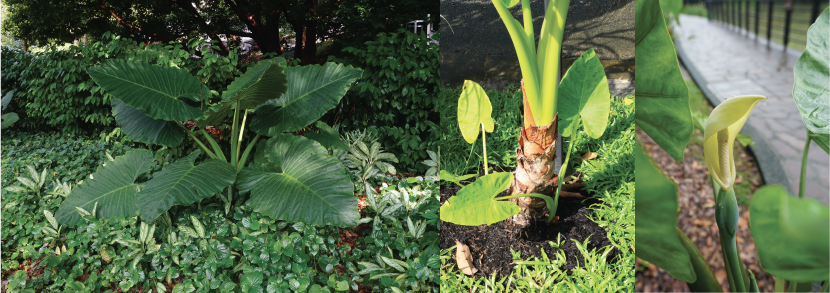
(Clockwise from top) Growth form, swollen stem and flower of the Giant Taro
The Giant Taro (Alocasia macrorrhizos) is a large rhizomatous aroid valued for its large, green glossy leaves whose shape resembles the ear of an elephant. These leaves grow upright, and can reach 1.8 m in height while the plant itself can grow as tall as 5 m!
Giant Taro is relatively easy to maintain indoors in a brightly lit and spacious area, as the leaves tend to grow big. It prefers moist, well-drained soil rich in organic matter and is tolerant of occasional flooding. Check the soil moisture before watering so that the roots do not sit for an extended period in wet soils.
While Giant Taro is often regarded as an ornamental plant, it remains a good source of carbohydrates in indigenous communities from the Asia-Pacific region where potatoes cannot grow – the swollen stems and tubers are harvested and treated to obtain starch and flour. This plant requires a lengthy processing period to ensure that all calcium oxalate crystals are removed through methods such as roasting, boiling or frying. In Papua New Guinea, young shoots are cooked as vegetables in coconut milk or fried together with onions, garlic and chilli.
Elephant Foot Yam
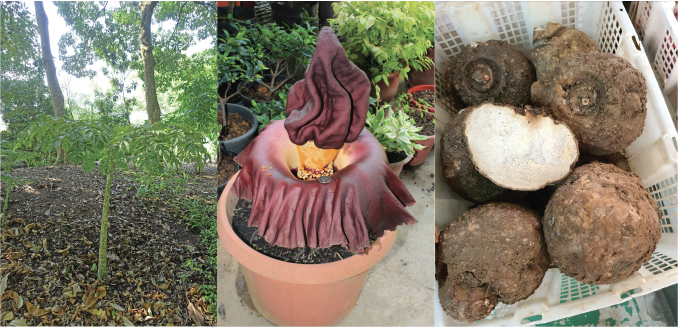
(From left) Growth form, flower and tubers of the Elephant Foot Yam
Photo credit: Soh Weijing and Shi Biying
The Elephant Foot Yam (Amorphophallus paeoniifolius) is a herbaceous plant that produces a single compound leaf that is segmented into three main leaflets, which are further divided into multiple lobes. The plant holds this large leaf up like an umbrella! The leaf stalk is decorated in light green blotches and the inflorescence is only produced after the leaf dies off. The inflorescence is funnel-shaped with a dark brown to maroon coloured spathe that encircles a spadix – a fleshy stem where the minute flowers are borne on.
Elephant Foot Yam prefers to grow in deep soils. Therefore, the depth of pot used should be twice the size of the tuber and filled with well-drained soil, rich in organic matter. It does poorly in heavy clayey or waterlogged soil, hence drainage is essential. The Elephant Foot Yam thrives under partial shade conditions and is suitable as an indoor plant with sufficient space for the spread of the leaf.
The tubers of the Elephant Foot Yam are consumed after thorough processing to remove the calcium oxalate crystals. In Indonesia, the tubers are cooked with vegetables or eaten as a titbit after being sliced, baked or boiled. In India, they are added into curries or fried, or made into pickles and chutney. The tubers are also used in a Bengali dish called OI Chingri Dalna (Elephant Foot Yam curry with prawn). In this dish, the tubers are boiled with curry spices and vegetables until the broth turns into a thick gravy.
Taro
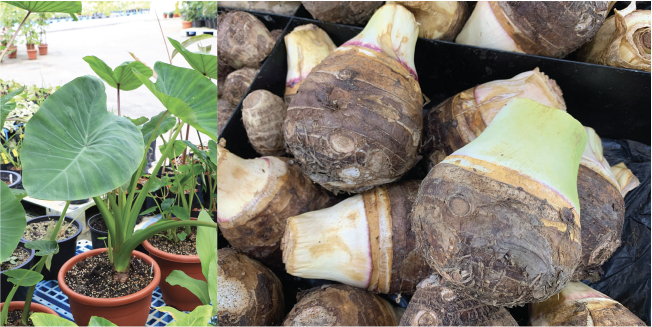
(From left) Growth form and tubers of Taro
One of the oldest cultivated crops in the Aroid family, Taro (Colocasia esculenta) or Yam can reach a height of 2 m and produces a short thick tuber that is round to cylindrical in shape. Unlike the Giant Taro, the leaf stalk (petiole) is attached near the centre of the leaf and the leaf droops.
The Taro plant is adaptable to most soil types including flooded conditions. Therefore, it is hard to overwater this plant. However, it does best in deep, loose and well-drained soil, rich in organic matter. Place the plant in a brightly lit spot with an occasional feed of balanced fertilisers.
All parts of the Taro plant are used in many cuisines. The tubers are used to make a wide variety of food including the local dessert orh-nee, which is primarily a boiled and sweetened paste made by pounding the tuber. The popular Chinese snack taro or yam cake is made by stir frying and steaming the tuber with other dried ingredients like shrimp and shiitake mushrooms. Poi is a Hawaiian and Polynesian dish that is made by cooking, pounding and fermenting grated taro and coconut. Other tasty snacks made from the tubers include taro pancakes, ice cream, chips and taro milk tea.
In Malaysia, the leaf stalks (petioles) from Taro are cooked together with coconut milk, prawns and meat. The leaves and petioles are also cooked as vegetables in China, Myanmar and Nepal.
Swiss-cheese Plant
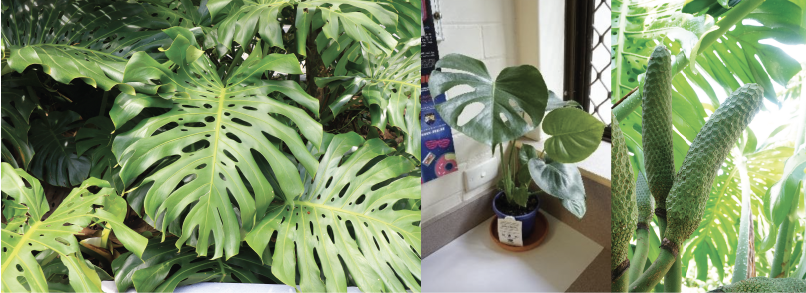
(Clockwise from top) Mature foliage, juvenile plant and fruits of the Swiss-cheese Plant
The Swiss-cheese Plant (Monstera delicosia) is a fast-growing herb that can climb up to 20 m high. Juvenile leaves are small with no lobes or ‘holes’ (fenestration). However, with age, leaves develop ‘holes’ and lobes of various sizes. These unique fenestrations contribute to why the leaves are frequently used as cut foliage in floral arrangements.
Under ideal growing conditions, this species takes about three years to flower and a year for the fruit to mature. So next time you spot a Swiss-cheese Plant, look out for flowers! The inflorescence is a corn-like spadix covered in hexagonal scales or tiles. This spadix will develop into a compound fruit that turns from creamy white to bluish green and the scales are distinctly separated when ripe.
The Swiss-cheese Plant prefers moist, well-drained soil under partial to full shade conditions. Given its fast-growing nature, stakes or trellises can help to support and train the plant. Alternatively, pruning the plant will keep it within a desired size.
The ripe elongated fruit of the Swiss-cheese Plant can be eaten fresh or harvested to make jellies or jam. It is said to taste like a mix of pineapple and banana. The unripe fruit is usually collected, placed in a paper bag and left in a warm place. As it ripens in the bag, the green scales fall off, exposing the edible pulp. The pulp can be added to ice cream. It is important to note that only the ripe sections should be consumed to avoid irritation to the throat and skin caused by the calcium oxalate crystals. Always consult your doctor before using or consuming its fruits for medicinal purposes. People who have more sensitive skin should err on the side of caution by avoiding it entirely!
Yautia
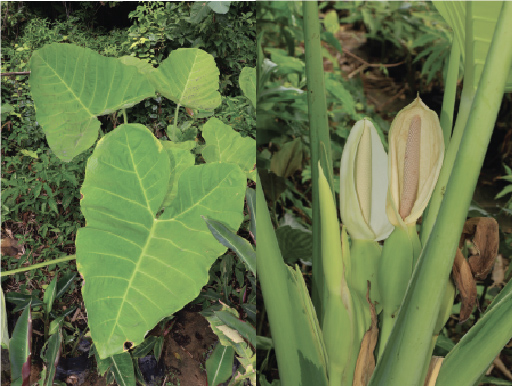
(From left) Growth form and flower of Yautia
Also known as Keladi Betawi, Yautia (Xanthosoma sagittifolium) is a fast-growing aroid widely cultivated as a food crop. It can grow up to 2 m tall, producing 10 or more tubers. The tubers are thick and short, varying in shape (from round to cylindrical) and colour (with white, pale yellow or pink flesh). Unlike the Giant Taro, the Yautia has arrow-shaped leaves that droop. The inflorescence has a boat-shaped spathe that covers the spadix like a hood.
This fast-growing species is suitable as a house plant as it prefers partial shade conditions. It grows best under moist but well-drained soil that is rich in organic matter. Avoid overwatering the plant to minimise root-rot issues.
Parts of the Yautia plant are prepared and consumed in many cuisines. The Chinese eat the tubers as a savoury snack during the Mid-Autumn festival by boiling them and dipping them in salt or sugar. In Cuba and Puerto Rico, the tubers are one of the main ingredients for dishes like sancocho (a soup which consists of meat, the tubers and vegetables) and pasteles (a boiled savoury cake wrapped in banana leaves). In Nigeria, tubers are substitutes for barley and sorghum in the brewing of lager beers. In Ghana, the leaves and petioles are added to sauces and soups.
Gardening with Edibles
The City in Nature vision seeks to bring greenery closer to all residents. The community plays a key role in the ownership and stewardship for nature which will benefit our health and well-being.
NParks is partnering residents to make Singapore our City in Nature and spark a love for community gardening through the Gardening with Edibles initiative launched in June 2020. Under this programme, some 400,000 free seed packets have been distributed to interested members of the public. Relevant resources are also available online, to guide gardeners along the way.
Also, NParks is expanding the allotment gardening scheme and the Community in Bloom programme, to welcome even more residents into the gardening family.
The Gardening with Edibles initiative is aligned with Singapore’s national strategy to strengthen our food resilience. The “30 by 30” goal, led by the Singapore Food Agency, aims to produce 30% of Singapore’s nutritional needs locally by the year 2030. The programme is jointly funded by founding partners DBS Bank and Tote Board through the Garden City Fund.
Learning More
If you are a gardening newbie, visit NParksSG, our refreshed YouTube Channel that serves as a one-stop repository for close to 300 video resources. It covers topics ranging from types of soil needed for your garden and how to plant, harvest and even cook your edibles.
For more information about the flora and fauna found in Singapore, please visit Flora and Fauna Web.
If you like what you read, follow us on Facebook, Instagram and Telegram to get the latest updates.
Text and photos by Low Wei Teng
About the writer
Low Wei Teng is a Horticulture Outreach and Heritage Trees manager with the NParks Horticulture and Community Gardening division. She and her team manage the NParks Flora and Fauna Web information portal to showcase and provide information on the plants found in Singapore’s landscape. She was also part of the editorial team for the recently published plant reference guide, 1001 Garden Plants in Singapore: A New Compendium.


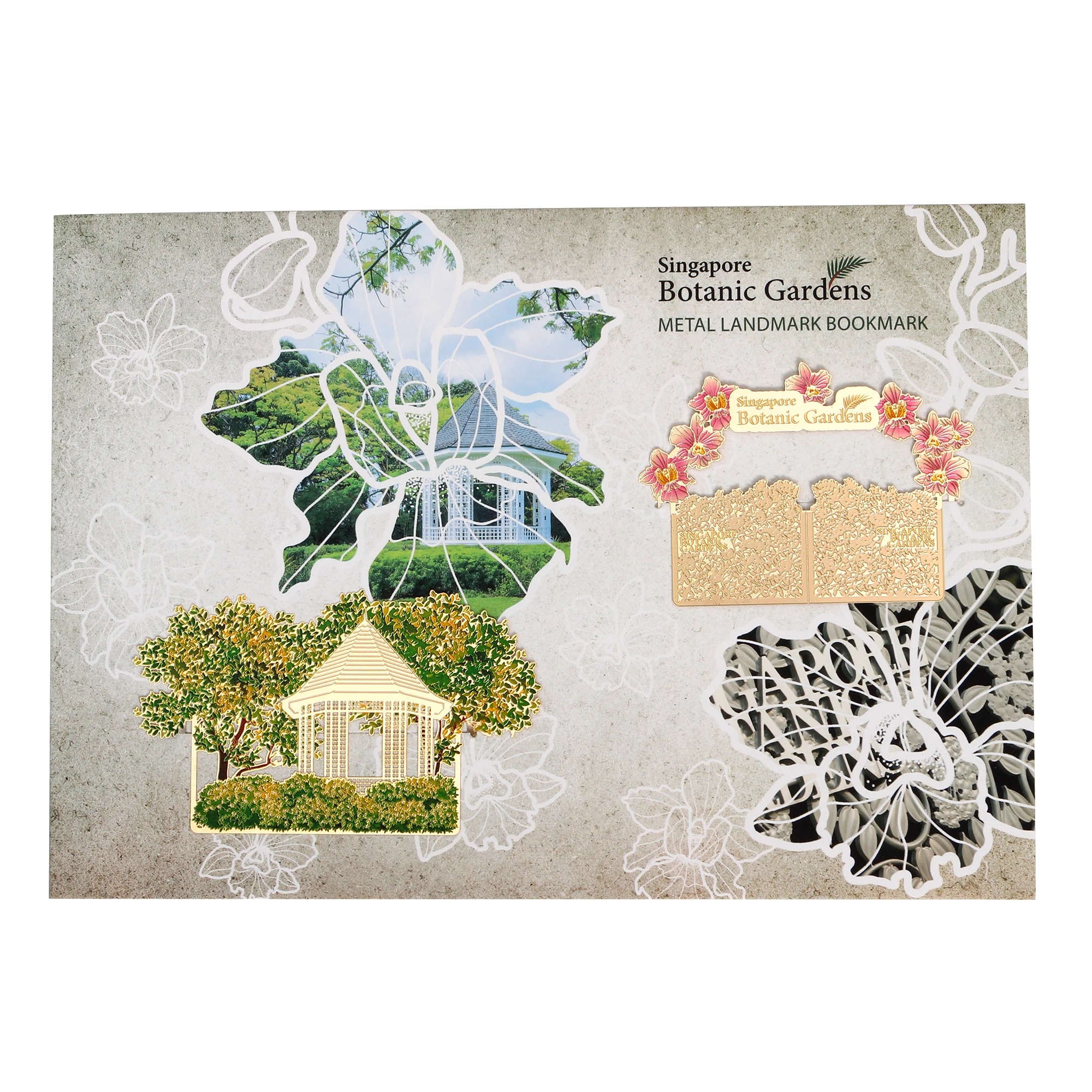

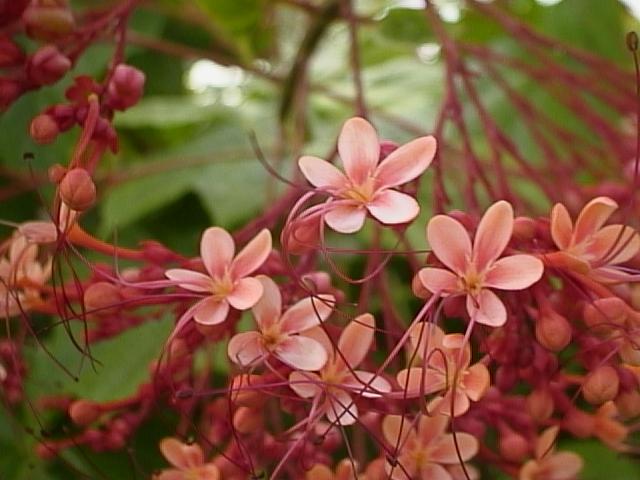
Have views or comments on this article? Let us know via this form. If you would like to give us feedback on any other areas relating to our parks and gardens, please submit via https://www.nparks.gov.sg/feedback